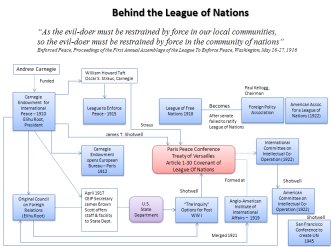
(Larger Image)
The Organization of Power
Part 7
Part 2 of this series included information on the The
Hague and the movement to begin building a system of
international law. Andrew Carnegie provided the money to build The
Hague. In 1910, Carnegie provided funding to establish the Carnegie
Endowment for International Peace. Elihu Root, a corporate lawyer with a
passion for international law - who was also a friend of Andrew Carnegie, was
the first president of the Endowment.
Elihu Root, through the Carnegie Endowment for International Peace, was the
founder of the Council on Foreign Relations.
[Side note: Do you remember when
George W. Bush used the term 'evil doers'?]
In 1912, the same year that the American Chapter of the
International Chamber of Commerce was founded in the U.S. the Carnegie Endowment for International Peace
opened an
office in Paris, France. The Carnegie Endowment, 100 year history page
had this picture and text:
|
|
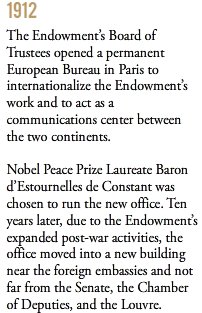 |
*QUOTE FROM CARNEGIE*
"As I grow older, I pay less attention to what men say. I just watch what they
do "
That's good advice. It's also good to remember that home is where the heart is and Andrew Carnegie's home and heart were in Scotland. Carnegie Council2 about Andrew Carnegie:
Carnegie’s philanthropic career began well before he sold Carnegie Steel. His first endowment was to his hometown of Dunfirmline, Scotland, donating 25,000 English pounds for the building of public baths. His first donation for a library was also in Dunfirmline, in 1882. (All together Carnegie would fund 2,507 libraries in the English speaking world: 1,689 in the United States, 660 in Great Britain, and 125 in Canada.)
His main "trusts," or charitable foundations, were (1) the Carnegie Trust for the Universities of Scotland (Edinburgh), founded in 1901 and intended for the improvement and expansion of the four Scottish universities and for Scottish student financial aid; (2) the Carnegie Dunfermline Trust, founded in 1903 and intended to aid Dunfermline's educational institutions; (3) the Carnegie United Kingdom Trust (Dunfermline), founded in 1913 and intended for various charitable purposes, including the building of libraries, theatres, child-welfare centres, and so on; (4) the Carnegie Institute of Pittsburgh, founded in 1896 and intended to improve Pittsburgh's cultural and educational institutions...
The Carnegie Foundation is misrepresenting Andrew Carnegie's first "philanthropic" endeavor in the United States. The Carnegie Institute of Technology2 in Pittsburgh was a vocational school for the sons of the steelworkers. It was an indirect business investment intended to serve the business interests of the profit-making business, the same as Bill Gates "philanthropy" for the schools today. The objection would be the misrepresentation of intentions and not necessarily the act. It's a social taboo to question the motivations of philanthropy whereas there is no such taboo on scrutiny of business investments and therein lies the problem with Foundations - especially perpetual Foundations.
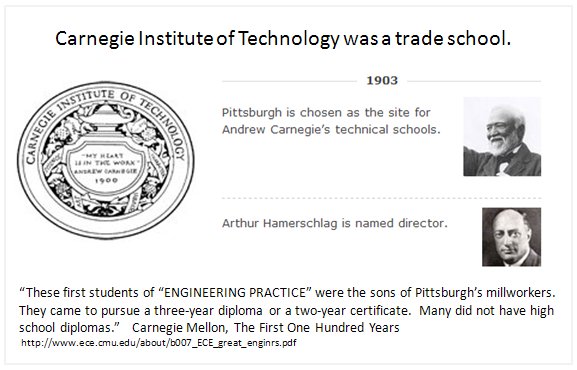
(5) the Carnegie Institution of Washington, founded in 1902 and contributing to various areas of scientific research; (6) the Carnegie Endowment for International Peace, founded in 1910 and intended to disseminate (usually through publications) information to promote peace and understanding among nations; and (7) the Carnegie Corporation of New York, the largest of all Carnegie foundations, founded in 1911 and intended for "the advancement and diffusion of knowledge and understanding among the people of the United States" and, from 1917, Canada and the British colonies.
A PBS biography of Andrew Carnegie had this to say:
"Carnegie was unusual among the industrial captains of his day because he preached for the rights of laborers to unionize and to protect their jobs. However, Carnegie's actions did not always match his rhetoric. Carnegie's steel workers were often pushed to long hours and low wages. In the Homestead Strike of 1892, Carnegie threw his support behind plant manager Henry Frick, who locked out workers and hired Pinkerton thugs to intimidate strikers. Many were killed in the conflict, and it was an episode that would forever hurt Carnegie's reputation and haunt the man
Carnegie also was one of the first to call for a "league of nations" and he built a "a palace of peace" that would later evolve into the World Court. His hopes for a civilized world of peace were destroyed, though, with the onset of World War I in 1914. Louise said that with these hostilities her husband's "heart was broken." Carnegie lived for another five years, but the last entry in his autobiography was the day World War I began."
As this page was being prepared, I read a number of essays and writings by
Andrew Carnegie. In one of them, that was written around 1886, he
mentioned communists several times. My impression was that communism was
the system implemented in Russia after their 1917 revolution. I looked up the word communism to see
is it was in my 1909 Webster's dictionary. It was -
communism, n [FR. communisme, from L. communis, common] The economic system or theory which upholds the absorption of all proprietary rights in a common interest, an equitable division of labor, and the formation of a common fund for the supply of all wants of the community; the doctrine of a community of property, or he negation of individual rights in property.
communist, n. 1. One who holds the doctrine of, or practices communism.
2. One who advocates government by communities
3. One who supported the Paris Commune in 1871
Bible Communist; see Perfectionistcommunitarian, n. One who believes in communistic life or belongs to a socialistic community
Tax-Exempt Foundations
The 1952 and 1954 hearings on the un-American activities of tax-exempt foundations included testimony by Ernest V. Hollis who was at the time, a recognized expert on the history of Foundations. This history traces back to 150 B.C. Most significantly for Americans is that our legal framework for Foundations traces back to Elizabeth 1601 - Statute of Charitable Uses1 which Hollis refers to as Act 43 Elizabeth or just Elizabeth 43. This history is important because throughout the entire history of frameworks for charitable giving, the structure begins with a philanthropic charter, but over time, the facade fades and the organization degenerates to become a machine of corruption with a pious and intellectual facade - my words. You don't need to read that in a book. You just need to know the nature of men who seek power and influence. The hearing record (that is available) of the Cox Committee and the record of the Reese Committee that followed may be found HERE.
Charles Dollard, President of the Carnegie Corporation of New York was also called to testify. The following is an excerpt from Dollard's testimony. The entire page is included because interestingly, the Hero Fund is a thread, but for the moment, focus on the Carnegie Foundation and the fund for "free pensions" from Mr. Carnegie. A company was established to manage the fund which became known as the Teachers' Insurance and Annuity Association (TIAA) which today is called TIAA-CREF.
|
|
The following chart was placed into the record of the Reese Committee, June 3rd hearing, 1954. The qualifier was that it was a simplified, functional diagram of the flow of money, men and ideas.
|
||||||||||
In the 1959 edition of George Ridgeway's updated edition of the Merchants of Peace, the foreword was written by James T. Shotwell, Carnegie Endowment for International Peace. In the graphic at the top, you'll notice that Shotwell's name is listed a number of times.
Shotwell was an
influential figure at the Versailles Peace talks in 1919, the treaty from which
created the League of Nations and in 1945 he was an active participant at the
San Francisco conference that approved the Charter of the United Nations as
shown in the graphic at the top of this webpage.
In his foreword, Shotwell wrote this:
If ever history had a lesson to teach, it is that which the thoughtful reader will draw from this history of international cooperation, for it shows how necessary is peace to a world that is based upon credit. Credit is not merely a term in business; it is a condition of human relationship. It binds the future to the present by the confidence which we have in the integrity of those with whom we deal. Since war is the denial of this confidence and the refusal of trust in our neighbors, it is the chief enemy of the business community and it follows that the business community should be the strongest force for peace in the world.
The truth.... credit is bondage. War occurs to prevent enslavement, to escape from enslavement or to enslave. War is about domination. Credit is about domination without weapons. Shotwell continues:
Merchants of Peace therefore should be regarded not as a closing chapter of a tale that is told but as the prelude to new and greater achievements in the future.
The present volume is, however, more than a prelude. Its theme is a drama itself, already begun on the stage of world history by the creative forces of economic peace and freedom. It tells how the interplay of interests has found expression in the world organization of the United Nations through such bodies as the International Chamber of Commerce, devoted to world peace through world trade.
Shotwell's involvement with Carnegie is significant because Shotwell was a writer of history and with Carnegie's money and the prestige of Columbia University, they've been involved in the degradation of our system of education ever since - as a strategy towards economic disarmament.
1919
The first world war slowed the march of the industrial collectivists operating behind the cloak of business until the end of the war in 1919. Chapter 3 of the Merchants of Peace, 1959 edition dedicates a chapter to the organization of the International Chamber of Commerce which was formally created in Atlantic City, NY, the street names of which were used for the board game of Monopoly. The following are excerpts from the chapter. The chapter can be read in full by clicking HERE.
|
-------->
-------->
--------> -------->
--------->
---------> --------->
--------->
--------->
--------->
-------->
|
Page 36
Continue reading the rest of chapter 3 HERE |
The International Chamber of Commerce restarted as a result of the 1919 meeting in Atlantic City for the purpose of post war reconstruction planning. At the meeting in Paris in 1920, they decided that Paris should be the permanent home for the International Chamber of Commerce. From this point on, you can trace the history of this group through the creation of the United Nations, the Marshall Plan for reconstruction after WWII and in the 1960's the re-constitution of the organs for the Marshall Plan (OEEC) to be the Organization for Economic Development (OECD) tracing further to the Economic Development Administration linking to the local office for Economic Development in your own community. (See John Gardner) Search my website for these acronyms and see what is there.
Above, in the references to
the Cox Commission hearing on tax-exempt foundations, I called out the reference
to the Hero Fund. Here is how it becomes
significant to today. On the American Chamber of Commerce Executives
website, Hero is on the action bar.

International Chamber of Commerce (ACCE is an affiliate) HERO - All Star Innovation Hero Award
Carnegie Foundations and the Merchants of Peace
Merchants of Peace was the name adopted by a group of international businessmen as
discussed in several places in this series. In 1938, George L. Ridgeway, then
Associate Professor of History at Wells College, wrote a book about them that
was sponsored by the Carnegie Endowment for International Peace and published by Columbia
University Press.
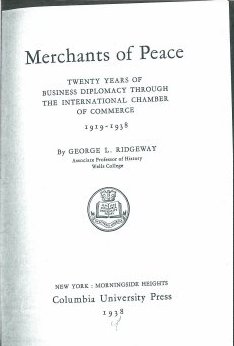 |
 |
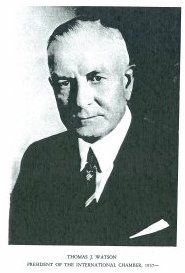 Thomas J. Watson, Chairman & CEO of IBM 1914-1956; President of the International Chamber of Commerce, 1937 |
The following is an excerpt from the
biography of
Thomas Watson on IBM's website:
Throughout his life, Mr. Watson maintained a deep interest in international relations. He entertained kings, presidents, prime ministers and ambassadors when they visited New York City. President Franklin D. Roosevelt once remarked, "I take care of them in Washington. I have learned to rely confidently on Tom Watson to take care of them in New York."
Mr. Watson adopted for IBM the slogan, "World peace through world trade," and made it internationally known. He said he advocated "the exchange not only of goods and services but of men and methods, ideas and ideals." He worked closely with the International Chamber of Commerce and in 1937 was elected its president.
Appendix A - Merchants of Peace
|
|||||||||||
Vicky Davis
January 21, 2014
__________________
1 Documentary History of Philanthropy and
Voluntarism in the United States, 1600-1900; The Statute of Charitable Uses
and the English Origins of American Philanthropy, Harvard University
website,
http://www.hks.harvard.edu/fs/phall/dochistcontents.html
Fishman, James J., The Political Use of Private Benevolence: The Statute of Charitable Uses, Pace University School of Law. http://digitalcommons.pace.edu/cgi/viewcontent.cgi?article=1486&context=lawfaculty
2 Carnegie Council 100th Anniversary About Andrew Carnegie: http://www.carnegiecouncil.org/people/data/andrew_carnegie.html History of the Carnegie Council: http://www.carnegiecouncil.org/about/info/index.html
3 Carnegie Mellon University, College of
Engineering, History Timeline,
http://www.cit.cmu.edu/about_cit/timeline.html
http://www.ece.cmu.edu/about/history.html